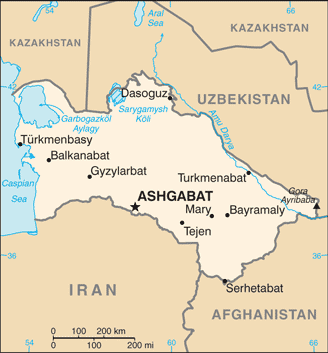Afghanistan–Turkmenistan border
The Afghanistan-Turkmenistan border is 804 km (500 mi) in length and runs from the tripoint with Iran to the tripoint with Uzbekistan.[1]

Description
The border starts at the tripoint with Iran on the Tedzhen river. Then proceeds eastwards in a series of mostly straight lines for about 90 km (56 mi), until reaching the Kushk River near the Afghan town of Torghundi, which it follows southwards for a short 15 km (9.3 mi) section. It then proceeds across land for 150 km (93 mi) in a north-westwards direction until reaching the Murghab River, which it follows northwards for 35 km (22 mi). It then continues across land north-westwards for 370 km (230 mi) , until reaching the Amu Darya river just to the north of the Afghan town of Khamyab. The border then follows the thalweg of this river up to the tripoint with Uzbekistan.[2]
The border traverses a thinly populated area consisting mostly of desert and some hills, except for the eastern-most section where the Amu Darya is paralleled by a road and railway on the Turkmen side.
History
The border was inherited from the old Soviet Union-Afghan border, which largely took its current shape during the 19th century Anglo-Russian rivalry in Central Asia known as the Great Game. With the Russian Empire having conquered the Khanate of Khiva and the Emirate of Bukhara, and with the British Empire controlling the British Raj, the two powers agreed to leave Afghanistan as an independent buffer state between them.[2]
In 1873 Britain and Russia agreed on a rough formulation of the border, with the Amu Darya declared to be the border going east from the vicinity of the village of Khwaja Salar to Lake Zorku, with the Wakhan Corridor to remain in Afghanistan. The western section of the border (i.e. the bulk of the modern Afghan-Turkmen boundary) was to be determined at a later date by a boundary commission.[2]
Tensions mounted as the Russians expanded further into what is now Turkmenistan in the early 1880s, reaching a crisis with the Panjdeh incident (near Sandykachi in what is now Turkmenistan), an area claimed by Afghanistan. Discussions calmed the situation and a joint Anglo-Russian boundary commission demarcated the boundary as it is today over the period 1885-88. As the village of Khwaja Salar could no longer be identified it was agreed that the boundary should meet the Amu Darya in the vicinity of Khamiab, Afghanistan.[2]
The eastern-most section of the border (now forming part of the Afghan-Tajik boundary) was not finally delimited until 1893-95, with the Afghans agreeing to waive any claims to lands north the Amu Darya. This agreement also stipulated the position of the land border in section east of Lake Zorkul up to China, with a series of boundary pillars subsequently erected.[2]
In 1921 a Soviet-Afghan treaty was signed whereby Russia agreed “to hand over to Afghanistan the frontier districts which belonged to the latter in the last century, observing the principles of justice and self-determination of the population inhabiting the same." However this treaty was never implemented, and was explicitly annulled by the Frontier Agreement of 1946, which kept the boundary as it was, with riverine islands to be subsequently allocated by a joint commission.[2]
In 1979 Soviet troops of the 40th Army crossed the border at Ymamnazar/Kushka as part of the Soviet Invasion of Afghanistan, en route to Herat and Kandahar.[3]
There have been a number of incidents in recent years connected to the ongoing conflict and instability in Afghanistan, prompting Turkmenistan to increase its military presence on the frontier.[4] In 2017 Turkmen president Gurbanguly Berdimuhamedow personally visited the border to inspect security arrangements there.[5][6][7]
Incidents
- There were several incidents along the border in 2014. In February Turkmen border guards killed a militant who crossed the border illegally and captured two others. In retaliation three Turkmen border guards were killed later that month. In May that year three Turkmen guards were killed by an armed group crossing the border from Ghormach District, Afghanistan.[8][9]
- In October 2015, several Taliban fighters were chased onto an island in the Amu Darya by Afghan forces, forcing Turkmenistan's border security to prevent them entering their territory. This incident occurred a few weeks after Turkmenistan strongly protested Kazakhstan's president Nursultan Nazarbayev expressing concern about the security situation along the Afghan-Turkmen frontier.
- In 2017, four fighters believed to be affiliated with the Islamic State were apprehended crossing illegally into Turkmenistan.[10]
Border crossings
Settlements near the border
Afghanistan
Turkmenistan
- Serhetabat
- Bashbeden
- Khodzhali
- Ymamnazar
- Bosaga
See also
References
- CIA World Factbook - Afghanistan, 8 September 2018
- International Boundary Study No. 26 - Afghanistan-USSR Boundary (PDF), 15 September 1983, retrieved 8 September 2018
- BBC Timeline: Soviet War in Afghanistan, retrieved 8 September 2018
- Ferghana News - Turkmenistan erects barbed wire fences on Afghan border, 16 October 2014, retrieved 8 September 2018
- 21st Century Asian Arms Race - Turkmenistan Is Obsessed With Protecting Its Afghan Border, 25 January 2018, retrieved 8 September 2018
- 21st Century Asian Arms Race - Turkmenistan Just Advertised Its Counter-Terrorism Muscle, 5 August 2018, retrieved 8 September 2018
- Forecast International - Turkmenistan Wary of Afghan Border, 16 August 2017, retrieved 8 September 2018
- More Turkmens Troops Killed Along Afghan Border, retrieved 8 September 2018
- Ferghana News - Turkmenistan erects barbed wire fences on Afghan bordern, 16 October 2014, retrieved 8 September 2018
- Forecast International - Turkmenistan Wary of Afghan Border, 16 August 2017, retrieved 8 September 2018
- Caravanistan - Turkmenistan-Afghanistan border crossings, retrieved 8 September 2018